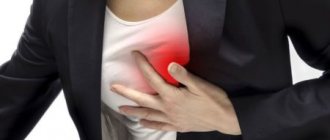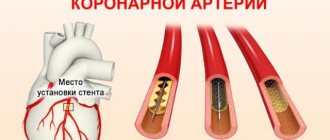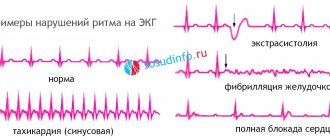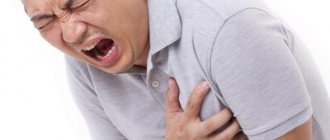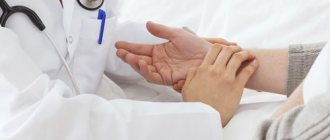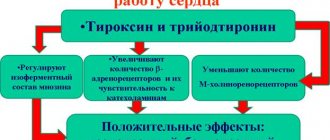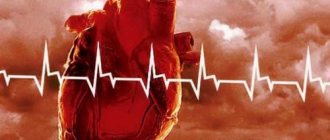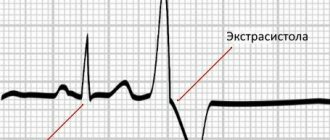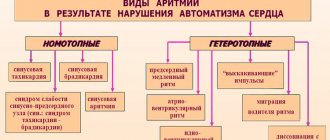Sinus tachycardia
This is a very common type of arrhythmia, characterized by a pulse above 100 beats per minute. Sinus tachycardia is either a normal variant or a sign of pathology of the heart, endocrine system, blood vessels and other organs. It all depends on the individual case.
The norm is periodic tachycardia - when the heart rhythm goes astray due to excitement, exercise, a cup of strong coffee, etc. You should worry if this happens constantly.
Pathological tachycardia is an alarming sign. The heart works at high speed, almost to the point of wear and tear. Under such conditions, it cannot cope with delivering the required volume of blood to the large and small circles, because with rapid contraction, the chambers are not completely filled.
As a result, cardiomyopathy develops - a primary lesion (expansion) of the heart muscle, fraught with a decrease in myocardial contractility.
Other causes of breathing problems
With VSD, breathing failures are not necessarily associated with neurosis. Such a symptom may also be secondary – against the background of other conditions.
- Apnea. The symptom, which usually affects people over 65 years of age, is not new to VSD. Sleep is that period of life when we can entrust the brain with one of the most important activities of our body, breathing. But if this is the brain of a VSD worker, it is not at all a fact that he will cope perfectly with the task assigned to him. It may not send the necessary signals for up to 15 seconds, leaving the sleeping person without gas exchange. As a result, relaxed soft tissues block the windpipe, and the person feels suffocated. Many people wake up abruptly at such moments, feeling panic and bewilderment. It is best to go to sleep on your side - then the muscles of the nasopharynx and diaphragm will not need such a large load.
- Full stomach. Eating to your heart's content is always pleasant, but do not forget that the brain sends you signals of satiety only 15-20 minutes after this has happened. There is no need to mention the confused brain of the VSD. Dystonics often experience problems during and after meals, because they cannot control the process of satiety, as well as their body’s reactions to satiety. Either the extrasystoles skip, then the breathing gets lost, and the heart beats strongly. As a rule, at such moments the body needs an increased dose of oxygen so that the gastrointestinal tract has the opportunity to properly digest food. Do not forget that with VSD, all the blood (and this is the fuel for the organs) is concentrated in the brain and heart - after all, VSD people are always running from danger. Therefore, during meals, and especially hearty ones, the body needs to somehow solve the problem of digestion. It does this by increasing the heart rate and forcing the respiratory system to swallow air chaotically. All this speaks for itself: you need to eat carefully - don’t be greedy and don’t harm yourself.
- Physical exercise. With VSD, the patient likes to take care of himself once again and lie on the sofa. But sometimes you have to do household chores, lift bags of groceries to the 5th floor or do vacuuming. At such moments, respiratory failure occurs, and the heart rate increases. This is because the heart muscle of the “pampered” VSDs is very weak - after all, it did not get the opportunity to be trained and strong. Therefore, in order to fully supply the body with oxygen, you need a lot of fresh air and hard work of the heart, which will drive blood through the veins. Always give yourself feasible physical activity so as not to fall into this vicious circle.
Trouble breathing is unpleasant and sometimes unimaginably frightening for VSD students. However, doctors convince: such situations never lead to death. Even after fainting, a person retains the ability to breathe. Therefore, you should not blame the brain in advance for unreliability and carelessness. It is important to help yourself: strengthen your nervous system, fill your life with reasonable physical activity and stop listening to your own lungs.
Symptoms and causes of tachycardia
Here's what causes this phenomenon:
- Chronic or acute heart failure.
- Ischemic diseases of various forms.
- Cardiomyopathies.
- Congenital and acquired defects.
- Inflammation in the myocardium, heart muscle, outer or inner layer of an infectious or autoimmune nature.
- Neurogenic disorders.
- Endocrine disorders.
- Anemia.
- Emphysema, asthma, chronic bronchitis.
- Taking contraindicated medications.
- Pregnancy.
Symptoms of tachycardia are as follows:
- Pain in the chest and sometimes in the heart.
- Shortness of breath (even at rest), feeling of lack of air.
- The heart rhythm is lost (becomes rapid).
- Fatigue and weakness.
- Dizziness.
- Insomnia, anxiety, irritability and emotional lability.
Over time, symptoms worsen. To avoid consequences, you need to make an appointment with a cardiologist at the first manifestations and undergo an examination.
Treatment of tachycardia
When it is determined why the heart rhythm is disrupted, treatment should begin immediately. If this phenomenon was provoked by tachycardia, then the first thing you need to do is reconsider your lifestyle, diet and regimen. Here are general recommendations:
- Quit alcohol and smoking.
- Don't overeat. You need to switch to fractional meals and eat small portions 5-6 times a day.
- Eliminate from your diet everything that contains caffeine (chocolate, strong tea, cocoa, energy drinks, etc.).
- Avoid spicy and hot foods.
- Eat more greens, fruits and vegetables.
- Sleep at least 8 hours a day.
- To walk outside. Engage in light physical activity (swimming, for example).
- Avoid situations that traumatize the psyche and stress.
Drug treatment can only be prescribed by a doctor. If tachycardia occurs due to problems with the thyroid gland, the patient will be prescribed thyreostatics (Mercazolil).
Beta-blockers, such as Oxprenolol and Pindolol, are considered good rhythm correctors. If drugs in this group are contraindicated, they are replaced with calcium antagonists. The best are Diltiazem and Verapamil.
If the cause of tachycardia is anemia, then you will need to take microelements, vitamins and iron supplements. For example, Ferrum-Lek. In case of heart failure, in addition to beta blockers, and other antiaris, Celanide and other glycosides.
The neurogenic form of the disease is treated by a psychotherapist and neurologist. Therapy is accompanied by the use of sedatives (Luminal, Relanium), tranquilizers, as well as Afobazol, Adaptol, herbal teas, hawthorn, valerian, motherwort, etc.
Traditional methods of dealing with heart rhythm disturbances
Treatment of pathology with folk remedies must be carried out under the supervision of a doctor. Recipes for preparing some medicinal infusions that normalize heart rate are given in the table.
| Folk remedy | Cooking diagram |
| Medicinal infusion based on lemon balm leaves and valerian root | Mix hop cones, yarrow herb and valerian roots in equal proportions. 20 grams of herbal mixture are poured with 150 ml of boiling water. The product is infused for at least 45 minutes. Filter the drink. Take 70 ml three times a day. |
| Infusion of blue cornflower flowers | Pour 40 grams of plant material into 300 ml of hot water. The flowers are infused for approximately 40 minutes. After this, the drink is filtered. Take 70 ml of the product twice a day. Take the infusion 25 minutes before meals. |
| Rowan bark decoction | Thoroughly grind 40 grams of bark and pour 0.6 liters of boiling water into it. Boil the mixture for at least 30 minutes, then strain. It is recommended to drink 50 ml of medicinal decoction twice a day. The duration of the treatment course is one month. |
| Decoction of mint and valerian leaves | Take 10 grams of medicinal herbs. Pour 0.25 liters of boiling water over the plant material. Leave the mixture for 45 minutes, then strain. Take 10 ml three times a day before meals. The average duration of course treatment is 14 days. |
Sinus bradycardia: causes
With this phenomenon, the heart rhythm also becomes disrupted. Only there is not an acceleration, but a slowdown in the rhythm - less than 60-50 beats per minute. Bradycardia, like tachycardia, may be normal. There is no need to worry if it is caused by the following reasons:
- Good physical fitness. In people accustomed to increased stress, the rhythm at rest slows down.
- Moderate hypothermia.
- Age.
- Idiopathic bradycardia.
- Stimulation of reflex zones.
Bradycardia can also be a side effect of taking certain medications. But the heart rhythm goes astray for other reasons, including pathological ones. Often bradycardia is caused by one of the following:
- Cardiopsychoneurosis.
- Pressure on the carotid sinus.
- Neurosis with autonomic dysfunction.
- Pressure on the eyeballs.
- Increased intracranial pressure.
- Peptic ulcer of the stomach and duodenum.
- Myxedema.
- Myocardial infarction.
- Cardiosclerosis.
- Myocardial dystrophy.
- Myocarditis.
Bradycardia can also be toxic. It develops with hepatitis, sepsis, uremia, poisoning with organophosphorus compounds, typhoid fever, hyperkalemia, hypercalcemia, etc.
Types of pathology
Often, arrhythmia is asymptomatic. Some patients show the following signs of the disease:
- cardiopalmus;
- darkening of the eyes;
- dyspnea;
- pain in the chest area;
- increased fatigue;
- fainting.
The listed symptoms do not always indicate that the patient has a heart rhythm disorder. Such signs are also observed during strong excitement.
There are several types of arrhythmia:
- tachycardia;
- atrial fibrillation;
- bradycardia;
- blockade;
- extrasystole.
The most severe form of the disease is atrial fibrillation. It can lead to serious consequences such as stroke or myocardial infarction.
Atrial fibrillation is often accompanied by pain in the chest area. The patient experiences a feeling of lack of air and dizziness. With pathology, the heart experiences enormous stress, the ventricles contract at a frequency of more than 100 beats per minute.
With atrial fibrillation, the risk of blood clot formation in the body increases. The disease can be stable, without exacerbations. Some patients periodically experience severe attacks of atrial fibrillation, which are called paroxysms.
The pathology most often occurs against the background of severe heart disease: coronary artery disease, mitral valve disease. Atrial fibrillation is also diagnosed in hypertensive crisis and heart attack.
With tachycardia, the heart rate increases significantly. With this disease, the blood supply to internal organs is disrupted. Therefore, the required amount of oxygen does not reach the heart.
With paroxysmal tachycardia, the heart rate increases suddenly (up to 200 beats per minute). This form of pathology occurs with chronic ischemia and heart disease.
With bradycardia, the heart rate can decrease to 40 beats per minute. In this case, the patient experiences severe fatigue, dizziness, and cold sweat. Factors provoking the occurrence of bradycardia:
- inflammatory process in the gallbladder;
- angina pectoris;
- the appearance of scar changes in the tissues of the heart after myocardial infarction;
- increased intracranial pressure.
Extrasystole is characterized by extraordinary contractions of the heart. With pathology, there is a feeling of short-term cardiac arrest and discomfort in the epigastric region. Extrasystole usually occurs due to lack of sleep, stress, or insufficient potassium content in the body.
Blockade
During blockade, the process of electrical impulse passing through a separate part of the heart is disrupted. It may be accompanied by bradycardia. Heart block is diagnosed in myocarditis and cardiosclerosis. The pathology develops with increased stress on the heart in athletes.
Symptoms and treatment of baricardia
Signs of an abnormal heart rhythm in the case of baricardia include the following manifestations:
- Dizziness.
- Weakness.
- Semi-fainting states.
- Fatigue.
- Labored breathing.
- Blood pressure fluctuations.
- Chest discomfort.
- Short-term visual disturbances.
- Impaired memory and concentration.
- Episodes of confused thinking.
Bradycardia is not accompanied by circulatory disorders and does not cause the development of clinical symptoms. But in extreme, advanced cases, the brain experiences hypoxia. This is why loss of consciousness and convulsions often occur. These conditions are dangerous and require emergency medical attention. Otherwise, breathing may stop.
So, if the heart rhythm is disrupted due to bradycardia, what should you do? If it has an extracardiac, toxic or organic form, then therapy is aimed at treating the underlying disease. For hemodynamic disorders, medications containing caffeine, ephedrine, isoprenaline, Eleutherococcus extract, ginseng root, belladonna, etc. are prescribed.
Paroxysmal tachycardia
This phenomenon also needs to be addressed. If a person complains that his heart sometimes loses its rhythm, there is a possibility that he has paroxysmal tachycardia. These are attacks with a contraction frequency of 140 to 220 (or more) beats per minute. They arise under the influence of ectopic impulses.
In etiology, this phenomenon is similar to extrasystole. The reasons for its occurrence are usually the following:
- Increased activity of the sympathetic nervous system.
- Sclerotic, dystrophic, necrotic, inflammatory lesions of the heart muscle.
- Ischemic disease, myocardial infarction, hypertension, defects.
- Longitudinal dissociation.
- The influence of psycho-emotional factors.
Paroxysmal tachycardia always begins suddenly and distinctly. It ends exactly the same. But the duration may vary. For some people it lasts a few seconds. For others – 2-3 days.
First, a person feels a jolt in the heart, which turns into rapid heartbeat. In parallel, the following symptoms are observed:
- Dizziness.
- Noise in the head.
- Feeling of heart squeezing.
- Sweating.
- Nausea.
- Mild subfebrile condition.
- Flatulence.
When the rhythm returns to normal, polyuria occurs - increased urination. Urine is released in large volumes. It has low density and light color.
If your heart rhythm and breathing are disrupted precisely because of paroxysmal tachycardia, you need to start treatment as quickly as possible. A prolonged condition can lead to low blood pressure, constant weakness and regular fainting.
When you take a deep breath, your heart rhythm goes wrong
TO THE SECTION EDITOR (reply within a few days)
Hello! A heart rhythm disorder that is characterized by changes in the frequency, sequence and regularity of heartbeats is called cardiac arrhythmia. With arrhythmia, the conductivity, excitability and automaticity of the heart may be impaired. Arrhythmia is quite often observed with heart defects, heart attack, as well as with changes in water-salt balance, intoxication, or dysfunction of the autonomic nervous system. Arrhythmia can also occur in healthy people during fatigue, colds or after drinking alcohol. There are dozens of types of arrhythmias in medicine. The reasons for the development of arrhythmia can be very different. Genetic characteristics, chronic diseases, lifestyle and many other factors can cause heart rhythm disturbances. To find out the cause of heart rhythm disturbances, you should undergo examination by a cardiologist. Based on the results of the examination, the doctor will be able to make an accurate diagnosis and prescribe treatment if necessary.
Hello! Based on the description you gave, your child most likely has vegetative-vascular dystonia. This disease is a vegetative disorder. more details
Hello! There is no such electrocardiographic diagnosis as left ventricular atrophy. The left ventricle is one of the four chambers of the human heart. more details
Hello! Atrial fibrillation is a condition in which there is a chaotic atrial rhythm, when the frequency of atrial waves can reach up to 600. more
Hello! Hypertrophic cardiomyopathy is caused by hereditary factors. This disease is characterized by myocardial hypertrophy of the left walls. more details
Hello! We do not prescribe treatment or diagnose diseases through online consultations, as this is contrary to medical ethics. Increased level. more details
After much stress, the following things began to bother me (in the last 2 weeks):
1) Extrasystoles. They always appear when I am nervous, often from a sharp breath, from overexcitation, from sudden movements (less often just out of the blue). Sometimes several in a row. At the same time, there is a jolt in the heart and a pause, shortness of breath, a feeling of air in the throat or in the heart - the feeling of air can last for hours. Breathing is disrupted, it’s as if I’m not breathing involuntarily, but I’m thinking about how to breathe - with my stomach or chest, sometimes I swallow air. There are sensations that the heart is beating somehow incorrectly, not rhythmically (sometimes) - The rhythm seems to go astray when inhaling (increases sharply when inhaling). Apparently I don’t feel all the extrasystoles, because when measuring pressure with an electronic tonometer, in 1/3 of the cases the pulse may beep 2 times in a row with a small interval, and then the pause is longer than usual (although I don’t feel this) 2) Pressure changes. From any emotions or fuss, the pressure jumps, the maximum was 160/100, it drops on its own, but before it normalizes, the pressure stays at 110/90, i.e. with a small difference between the top and bottom. And this is an unpleasant feeling. My blood pressure is usually low at 100/70, sometimes it drops to 90/65. If I take my blood pressure several times over 10 minutes, I can get a wide range of numbers (125/80, 100/70). I can’t drink tea, my blood pressure reacts strongly to it. 3) Pre-fainting states of 2 types: - usually in the evening on the way from work - out of the blue there is a feeling of internal tension, pressure rises, turbidity, pulse rises. There is no panic, but when I feel that I am alone on the street and could fall, this naturally causes fear and intensifies the crisis. Somehow I get home - it gets better, although the unpleasant sensations after getting up persist for several more hours (a feeling of swelling in the arms and legs (but there is no swelling), a feeling of the unreality of what is happening) - usually in the morning (less often) there is a feeling that the heart is beating weakly, the pulse is weak and rare (55-60), cold hands, weakness in the arms, semi-fainting state. But when I realize that I’m about to fall, panic appears and my pulse quickens. The pressure is normal or low. Sometimes such sensations go away if you eat. I'm already afraid to go outside.
I have had VSD all my life with long intervals of remission, and I have cervical osteochondrosis. The other day I had an echocardiogram (I do it once every 2 years, because there is a 6 mm MV prolapse with grade 1 regurgitation) - no changes. The cardiogram was done in the fall after the appendectomy - the norm (but then I did not have such symptoms).
Which doctor should I contact? What research needs to be done?
Respiratory arrhythmia is considered a juvenile disease, as it most often occurs in children and adolescents. The peculiarity of this disease is that such patients usually do not complain of any health problems. Without visiting a doctor, you may not notice anything. This type of arrhythmia occurs rarely in adults. There is a relationship between the functioning of the respiratory tract and the cardiovascular system.
Changes in heart rate during inhalation and exhalation
It has been found that in adolescents and children, the heart rhythm changes during deep breathing. This is expressed in the fact that the heartbeat becomes faster when inhaling, and slower when exhaling. In adults, this phenomenon is observed very rarely, but there are still reasons for this:
- prolonged nervous state;
- stress;
- suffered a serious illness;
- taking medications;
- smoking.
It is difficult to determine this disease based on its symptoms, so people do not notice it. If it occurs in young people, it is considered normal, so it is difficult to call it a separate disease. This type of heart arrhythmia is different in that if it is detected in children, there is no need to worry, since it will go away on its own over time.
There is no need to worry about the fact that respiratory arrhythmia was discovered during the examination. However, completely relaxing will also not be useful, because it can be called a condition that may indicate the presence of other diseases. Let's look at four interesting facts about the respiratory type of cardiac arrhythmia.
- It can be a companion to some heart disorders.
- Respiratory sinus arrhythmia is observed among healthy people, especially, as we have already learned, among children of all ages.
- Its appearance may indicate that the patient's condition has improved. This can occur after myocardial infarction (during the rehabilitation period). severe and acute infectious diseases and after rheumatic carditis.
- It may disappear with certain heart diseases, for example with inflammation of the myocardium, congenital heart defects, rheumatic diseases of the heart muscle, as well as with the first problems with blood circulation.
This type of arrhythmia may be confused with the non-respiratory sinus type. However, the latest definition suggests that there is no connection with the breathing process and oxygen saturation of the blood. Although this connection is fully confirmed in the respiratory form.
Are there methods that allow you to determine respiratory arrhythmia without accompanying symptoms? Of course. The main method in this case is ECG. As the position of the heart changes, minor changes appear on the ECG, especially in the P wave.
If the condition we are discussing indicates that there are other heart diseases, then it is imperative to identify them. In addition to the ECG, there are a number of other examinations: echocardiography, angiography, and so on.
Diagnosis of disease using ECG
Depending on the results of the examination, treatment is prescribed. The respiratory type of arrhythmia itself does not require treatment. However, if there are concomitant diseases, after a thorough diagnosis, high-quality treatment should be carried out. You cannot choose medications on your own, as self-medication can cause serious harm. Of course, prevention is always important, even before going to the doctor. But often, medical treatment must be added to a correct and healthy lifestyle, which should only be prescribed by a doctor. This way, you will be able to avoid complications that could threaten your health.
Respiratory arrhythmia in itself does not pose a threat to a person and can even indicate an improvement in his health. But in any case, you need to visit a doctor, as there is a possibility that a new disease will be discovered. A correct lifestyle and following the advice of your doctor is the key to a long life.
So, although the work of our heart is carried out autonomously, the body still has several levers of influence on its activity. One of these levers is the so-called vagus nerve (nervus vagus).
It should be noted that in different people at different periods of time the influence of breathing on the work of the heart is not the same, therefore respiratory arrhythmia can appear and disappear with the ECG on different days. In addition, some doctors do not pay attention to it, due to the fact that they consider it the norm or simply do not want to frighten, and then also reassure patients.
I suggest you a small experiment, for this you just need to learn how to count your pulse in 15 seconds. Lie down comfortably, relax, place the thumb and middle finger of one hand on the radial artery of the other hand (see picture) and start counting your pulse. Then make the deepest possible entrance, tense your abdominal muscles and remain in this state for 15 seconds, remembering to count your pulse. You will see for yourself how much slower the pulse has become; sometimes the heart rate drops to 40 beats per minute and this is the norm.
So if respiratory arrhythmia scares you, inhale, exhale and forget about it.
In an adult, respiratory arrhythmia appears as a result of a nervous state, severe exhaustion, or after suffering a severe illness. The process of changing the rhythm of the heart is directly related to respiratory function, and therefore it is called respiratory arrhythmia.
Respiratory arrhythmia is expressed by an increased number of contractions of the heart muscle during inspiration. When exhaling, on the contrary, a person’s pulse slows down. As a result, heart contractions have the character of arrhythmia. Usually, after a certain period, attacks of respiratory arrhythmia disappear on their own.
Sometimes this disease is observed in patients who have recently suffered from an infectious disease or in people suffering from vegetative-vascular dystonia. Airway arrhythmia often occurs in heavy smokers.
Often a person does not even notice respiratory arrhythmia, because the symptoms are not felt and the blood circulation is normal. This distinguishes it from other forms of arrhythmia.
- taking anamnesis;
- orthostatic test (inclined test);
- inclined test (orthostatic test);
- echocardiography;
- Holter monitoring (an excellent method of electrophysiological instrumental diagnostics);
- ECG (electrocardiogram).
Doctors consider respiratory arrhythmia to be normal and cannot be treated. You can take a preventive course based on laboratory test results. The doctor may prescribe immunomodulatory drugs, vitamin therapy, and physical therapy.
Therapy of paroxysmal tachycardia
If this is precisely why the heart rhythm is disrupted, the doctor will prescribe treatment taking into account the duration of the attacks, the form of the arrhythmia, and the presence or absence of complications.
Patients are often hospitalized. If attacks occur more than twice a month, surgical treatment may be prescribed.
To urgently stop paroxysm, you need to resort to one of the vagal maneuvers. This is the Valsalva, Aschner and Chermak-Goering test, straining, inducing the gag reflex, wiping with cold water, etc.
Emergency care involves the introduction of universal antiarrhythmics into the vein. The most effective are “Novocainamide”, “Propranolol”, “Aymalin”, “Quinidine”, “Ri”, “Isoptin”, “Cordarone”.
Even those patients whose heart loses rhythm for a few seconds must be observed by a cardiologist. Only a doctor can determine the volume and regimen of antiarrhythmic therapy.
Extrasystole
Perhaps a person has this variant of the disorder if he has noticed that his heart rhythm has long been lost. Therefore, it is also worth talking about the causes, signs and treatment of extrasystole.
This disorder is characterized by extraordinary contractions of the entire heart muscle or its individual parts. Manifested by the following symptoms:
- Feeling of heart sinking.
- Lack of air.
- Anxiety.
- Angina pectoris. Occurs due to decreased cardiac output.
- Fainting, paresis.
- Interruptions and fading of the heart.
- Hot flashes.
- Discomfort, weakness, sweating.
The causes of extrasystole include the following factors:
- Chemical and nutritional factors.
- Alcohol consumption.
- Smoking.
- Drugs.
- Vegetative dystonia.
- Osteochondrosis of the cervical spine.
- Neuroses.
- Myocardial lesions.
- Feverish states, thyrotoxicosis.
- Violation of the ratio of calcium, magnesium, potassium and sodium ions in myocardial cells.
If the heart rhythm is disrupted due to extrasystole, what should you do? First of all, contact a cardiologist and neurologist. Typically, patients are prescribed sedatives (peony tincture, lemon balm, motherwort), sedatives (Diazelam, Rudotel).
But this is just an example. The dosage of antiarrhythmic medication is prescribed and adjusted only after Holter ECG monitoring. As a rule, medications such as Sotalol, Procainamide, Lidocaine, Amiodorone, Quinidine, Diltiazem and ethylmethylhydroxypyridine succinate are prescribed.
Symptoms of extrasystole
Extrasystole is a disease that occurs without pain. People feel heart palpitations without knowing what it is. Signs of extrasystole are divided according to the type of disease. A single atrial extrasystole, for example, may not cause any inconvenience to a person, sometimes manifesting itself as separate heart beats. With frequent or group extrasystoles, specific signs appear:
- rapid heartbeat;
- hard breath;
- angina pectoris;
- weakness.
Ventricular extrasystole manifests itself:
- heart rhythm disturbances,
- interruptions in the functioning of the heart muscle
- migraines.
Often with extrasystole the following occur:
- excessive sweating;
- pale skin color;
- panic.
Important! Rare atrial extrasystole is observed more often in cardiac pathologies and occurs at night in a horizontal position.
Atrial fibrillation
This phenomenon is also called atrial fibrillation. This disorder is characterized by atrial contraction at a rate of 350-700 per minute. It is the most common type of arrhythmia. And if a person thinks about why the heart rhythm is off, then there is a high probability that he is suffering from fibrillation.
The following conditions contribute to the occurrence of this pathology:
- Ischemic disease.
- Tumor and inflammatory lesions of the myocardium.
- Arterial hypertension.
- Heart defects.
- Cardiomyopathies.
- Heart failure.
- Diabetes.
- Increased thyroid function.
- Problems with excess weight.
- Obstructive processes in the lungs of a chronic nature.
- Postponed surgeries.
- Electric shock.
- Alcohol addiction.
Symptoms of fibrillation are as follows:
- Pain in the heart and chest discomfort.
- Weakness.
- Dizziness and even fainting.
- Frequent urination.
- Dyspnea.
- Change in quality of life.
- Decreased exercise tolerance.
- Impaired sensitivity.
Any, even minor manifestations cannot be ignored. And in a minimally pronounced course, a cardioembolic stroke may occur, fraught with neurological disorders and other unpleasant consequences.
Treatment of atrial fibrillation
The causes and symptoms characteristic of this violation were discussed above. Has your heart rhythm gone wrong and the doctor has diagnosed atrial fibrillation? It's time to start treatment. It can be aimed at one of the following purposes:
- Restoration of sinus rhythm.
- Prevention of thromboembolism.
- Prevention of rhythm disturbances.
- Maintaining heart rate.
Initially, the doctor prescribes medication. If it turns out to be ineffective, then you have to switch to electropulse therapy. As a last resort, radiofrequency ablation is prescribed - treatment using radio waves.
For drug restoration of rhythm, blockers of slow calcium and sodium channels, cardiac glycosides, beta blockers, antiarrhythmics, as well as potassium and magnesium preparations are used.
Bradyarrhythmia
This is the last type of disorder and the most common, which is characterized by irregular heart rhythm. Bradyarrhythmia is characterized by a contraction frequency of less than 60 beats per minute.
This phenomenon is due to a variety of reasons. The danger of this disorder is that if the number of beats is less than 45 per minute, then the risk of loss of consciousness increases significantly.
Bradyarrhythmias are various arrhythmias - atrioventricular and sinoatrial blocks, sinus node arrest, sick sinus syndrome, replacement rhythms, bundle branch blocks.
In fact, problems associated with heartbeat can indicate any pathology. There are dozens of them. Therefore, to clarify the cause and receive competent medical recommendations, you need to go to a cardiologist. The type of rhythm disturbance, the degree of change in conductivity, the type of blockade, the direction of propagation of excitation waves and many other features can be determined after an ECG.
Is arrhythmia dangerous for life?
The structure, the primary source of evolution of any heart rhythm disorder, is varied, as are the clinical symptoms. It is advisable to begin treatment of disorders of this nature only after a full medical examination. The main thing is to find the real cause, which became the generator of the formation of cardiac arrhythmia. Pulse surges with all that entails are observed not only in adults and the elderly, but also in children.
In adults
Let's find out why cardiac arrhythmia is dangerous in adults and what its consequences are. The level of risk depends on the type of disease. Often, heart rhythm disturbances are accompanied by strong tremors in the chest, disruptions, increased or slower heartbeat. Similar symptoms are observed in the case of benign arrhythmia, which does not threaten human life. A consultation with a cardiologist will not hurt, as will topical treatment.
Severe or malignant types of cardiac arrhythmia occur with organic defects. Such disorders lead to disruptions in the circulatory system, as a result of which the organs do not receive the required amount of oxygen. This type of cardiac arrhythmia causes pain in the chest, decreased blood pressure, and the development of heart attacks. This requires emergency assistance from a specialist. The main threat of heart disorders in adults is that the attack begins abruptly and progresses rapidly. If you do not see a doctor, there is a risk of death.
In children and adolescents
Children are no less susceptible to arrhythmia. A child with a negative prognosis before puberty often has atrial fibrillation, paroxysmal tachycardia, and other cardiac disorders. There are risks of sudden death in the case of severe variants of sinus node arrhythmia, tachyarrhythmia (especially in the presence of ischemia, arterial hypotension, loss of consciousness). The best basic “pill” for violations is to seek help in time.
In adolescents, temporary sinus arrhythmia is observed, which does not have serious complications. The causes of heart disease often lie in emotional experiences, stress, and problems communicating with peers or family members. To be on the safe side, it is better to contact a family psychologist and identify violations in advance. Here, “mental” treatment of heart disease is more likely to be required.
During pregnancy
Almost all pregnant women experience rhythm disturbances. As the fetus grows, the load on organs, including the heart, increases. There are several reasons that increase the chances of the disease occurring: congenital heart disease, hereditary predisposition. Women in position are susceptible to extrasystole, atrial fibrillation, and tachycardia. For the first type of disorder, no special medical procedures are prescribed; newborn arrhythmia will not manifest itself. The last two threaten the fetus with hypoxia and in rare cases lead to miscarriage. It is worth contacting a cardiologist in time.
